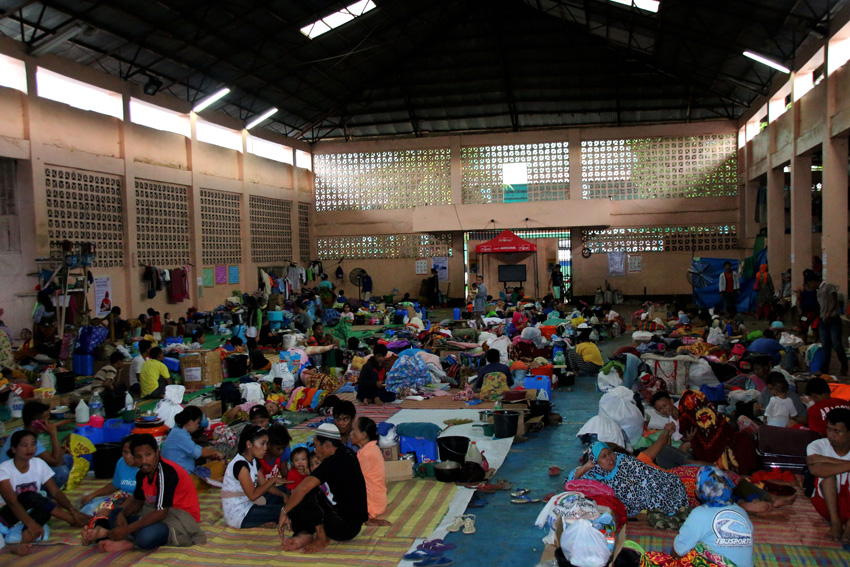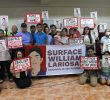
Inside the evacuation center in Balo-i town, Lanao del Norte. (Alex D. Lopez/davaotoday.com file photo)
DAVAO CITY, Philippines — Recent report of unspent funds for Marawi City has resurrected the anger and frustration of victims, not only of the Marawi City fighting in 2017, but also of the other victims of calamities where billions of funds have been reported coming in from donor nations and private groups but whose actual assistance remained begging for answers as to where it went.
A group of Moro residents of Marawi City aired their frustration over the unspent donations funds of P36,920,725.00 with only P10,000 has been released as financial assistance to only one beneficiary of a dead victim of the Marawi siege, based on the report of the Commission on Audit (COA).
The Moro Consensus Group said “it deprived thousands of IDPs (internally displaced persons) whose conditions last year could have been alleviated had the donation been used for their basic needs” talking about the unutilized donation that the government assured to be intact and were kept in the bank.
It said the unspent fund and the other P10 billion funds allocated under the General Appropriations Act for Marawi rehabilitation in 2018 to Bangon Marawi Comprehensive Rehabilitation and Recovery Program “should be used for rehabilitation and assistance of every Marawi residents affected by the war”
The group pointed out that the donations should be spent to the more than a hundred thousand IDPs with the majority of them still living in the tent city and other evacuation areas in and out of Marawi City.
“We appeal to the government to use the remaining 36.91 million donations to alleviate the plight of the Marawi Siege victims as this were the purpose of the donation in the first place. We also want to know exactly how much of the 10-billion peso the budget allocated for the Bangon Marawi Comprehensive Rehabilitation and Recovery Program last year was actually released,” the Moro Consensus Group said in a statement signed by Drieza Lininding.
The Department of Finance (DoF) reported in April that the government already released P24.4 billion so far. DoF Secretary Antonio Joselito Lambino II said P10.9 billion was coursed through relief and livelihood assistance projects and the construction for transitional shelters and evacuations centers while the other P1.5 billion was given to the National Housing Authority.
In June 2018, the Department of Budget and Management (DBM) reported that they have released P5.1 billion in 2017 and another P54.1 million in 2018 to fund local relief projects for affected residents.
The group has demanded an explanation “as to why only half of the P10 Billion pesos allocated under the GAA for Marawi rehabilitation through the National Disaster Risk Reduction and Management Council (NDRRMC) was released to various agencies last year.
“We demand transparency in the use of funds – whether allocated or donated – for Marawi.”
Turtle-Style help
Dr. Efleda Bautista, chairperson of People Surge an alliance of the survivors of Typhoon Yolanda based in Eastern Visayas said “poor performance and the lack of transparency” has always been the top issue the government was showing its people over the years.“It is not because there’s a change of administration, what’s the problem is that they are not doing the job well putting as victims as collateral damage to their promises” said Dr. Bautista.
Dr. Bautista told Davao Today that up to now, many of the residents affected in Eastern Visayas were unable to avail of the emergency shelter assistance with the majority of them still residing in the hazard zones due to poor living condition.
Bautista set the housing project of the government under the NHA as an example “for the slow-paced assistance” to the survivors of Typhoon Yolanda saying it should be a priority to construct safe houses for the resettlement area of survivors not long ago.
“But what happens is, aside from the construction is late it is also substandard,” told Dr. Bautista. She said the group is now conducting a study on the housing project for the survivors as they already received reports of some cracks on the wall of some housing unit after an earthquake happened 3 weeks ago.
Baustista said transparency could be one thing “as there is still a huge sum of fund needed to utilize for the survivors as widespread poverty and hunger continue”.
“We want accountability over these misused and unused funds. We should learn our lesson very well as many in the government enjoys the money intended to help us” said Dr. Baustista.
Super Typhoon Yolanda, one of the most powerful tropical cyclones ever recorded brought devastation reaching ₱95.5 billion, including the damage of 987,545 houses. At least 6,300 people died.
Also in ComVal
The poor scenario of Typhoon victims and survivors do not only happening in the Visayas as many residents of Compostela and Davao Oriental also utter the same frustration over the years.
Typhoon Pablo killed almost 1,100 people, displaced tens of thousands of residents and ravaged widespread agricultural farms.
The government allotted P5.6 Billion through Task Force Pablo to build new homes for 14,089 families in Compostela Valley and 3,391 others in Davao Oriental through the NHA and another P1.8 billion allotted to the Department of Social Welfare and Development (DSWD) for the additional 15,629 homes in Compostela Valley.
But in an interview with Compostela Farmers Association chairperson Noli Villanueva also lambasted how poor government service was towards disaster survivors despite billions of donations of the fund and big budget allocations.
At the height of the disaster, many promises were made “because the national and local election at that time is happening”.
On April 2013, thousands of typhoon survivors barricaded the major highways to demand relief assistance allegedly hoarded by the provincial government and another set of camp out outside the DSWD 11 regional office whose officials refused to release 10,000 sacks of rice demanded.
“Whether it is relief or housing, what is clear and true is it is we suffered because of inefficient and slow government work. After the typhoon, we were left behind struggling and poor,” said Villanueva.
For example, Villanueva said government promised to give 10 pieces of iron sheets to families to rebuild their houses but he said he personally received only four pieces while others did not even get one especially those in the hinterland areas.
He also said they have been receiving a report from those residents who obtain houses under NHA that there are defects, some faulty electrical installations or with cracks in the walling
“Many years after the typhoon happened, many of us were not able to occupy the house build for the Typhoon survivors. The process to acquire a unit is too long and difficult plus those houses are substandard, unsafe for public use,” said Villanueva.
Villanueva also added that “poor people like them do not have the capacity to file a case” against those agencies and officials in the government assigned to alleviate their poor condition.
Never-ending Sacrifice
Two years later after the siege, residents of 96 barangay are still continuously living poorly with 400 displaced families in three evacuation centers and other 11,000 individuals staying at home based evacuees or ‘unrecognized bakwits’.
With the stop of receiving relief assistance in the last quarter of 2018, many residents cry of poverty and hunger saying they need full-blown assistance from the government who receives both monetary and non-monetary support from the national and international community, told by Moro Consensus Group.
Secretary Eduardo del Rosario, chairperson of the Housing and Urban Development Coordinating Council promised residents that they could return to their homes by July this year to start the repair, while in those hardest hit areas, the operation to clear the debris was still going on.
President Rodrigo Duterte said however, he could no longer spend any more money for the rebuilding of the ruin Islamic City as it has the potential to breed another jihadist.
“I don’t think that I should be spending on their buildings. I will not spend money. The people there have plenty of money,” the President’s statement in April.
While Marawi people still battling on their right to come back to their home in ‘Ground Zero’ and enduring the distress in the evacuation centers, many typhoon survivors complained that they were harassed while demanding for assistance.
In Compostela Valley leaders of typhoon survivors group like Marcelo Monterona, Pedro Tinga and Cristina Jose were killed as they led the protest in the region to demand fast and quality relief and rehabilitation assistance.
Joining the protest according to Villanueva was also a basis “on whether or not a survivor could avail of governments help or not.”
“Recently, those who joined us in mobilizations became a target of human rights violations saying that we are backed with the New People’s Army or a direct member,” Villanueva added.
In Eastern Visayas, People Surge also reported of similar harassments against aggrieved communities in Samar and Leyte. (davaotoday.com)










